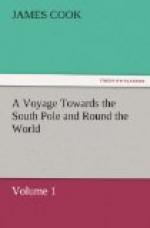I was therefore ordered to proceed directly to Otaheite; and after astronomical observations should be completed, to prosecute the design of making discoveries in the South Pacific Ocean, by proceeding to the south as far as the latitude of 40 deg.; then, if I found no land, to proceed to the west between 40 deg. and 35 deg., till I fell in with New Zealand, which I was to explore; and thence to return to England by such route as I should think proper.
1768 Cook’s first voyage.
In the prosecution of these instructions, I sailed
from Deptford the 30th
July, 1768; from Plymouth the 26th of August, touched
at Madeira, Rio de
Janeiro, and Straits Le Maire, and entered the South
Pacific Ocean by Cape
Horn in January the following year.
I endeavoured to make a direct course to Otaheite, and in part succeeded; but I made no discovery till I got within the tropic, where I fell in with Lagoon Island, Two Groups, Bird Island, Chain Island; and on the 13th of April arrived at Otaheite, where I remained three months, during which time the observations on the transit were made.
I then left it; discovered and visited the Society Isles and Oheteroa; thence proceeded to the south till I arrived in the latitude of 40 deg. 22’, longitude 147 deg. 29’ W.; and, on the 6th of October, fell in with the east side of New Zealand.
I continued exploring the coast of this country till the 31st of March, 1770, when I quitted it, and proceeded to New Holland; and having surveyed the eastern coast of that vast country, which part had not before been visited, I passed between its northern extremity and New Guinea, landed on the latter, touched at the island of Savu, Batavia, the Cape of Good Hope, and St Helena,* and arrived in England on the 12th of July, 1771.
[* In the account given of St Helena in the narrative of my former voyage, I find two mistakes. Its inhabitants are far from exercising a wanton cruelty over their slaves, and they have had wheel-carriages and porters’ knots for many years.]
In this voyage I was accompanied by Mr Banks and Dr Solander; the first a gentleman of ample fortune; the other an accomplished disciple of Linnaeus, and one of the librarians of the British Museum; both of them distinguished in the learned world, for their extensive and accurate knowledge of natural history. These gentlemen, animated by the love of science, and by a desire to pursue their enquiries in the remote regions I was preparing to visit, desired permission to make a voyage with me. The Admiralty readily complied with a request that promised such advantage to the republic of letters. They accordingly embarked with me, and participated in all the dangers and sufferings of our tedious and fatiguing navigation.
The voyages of Messrs de Surville, Kerguelen, and Marion, of which some account is given in the following work, did not come to my knowledge time enough to afford me any advantage; and as they have not been communicated to the world in a public way, I can say little about them, or about two other voyages, which, I am told, have been made by the Spaniards; one to Easter Island in the year 1769, and the other to Otaheite in 1775.




